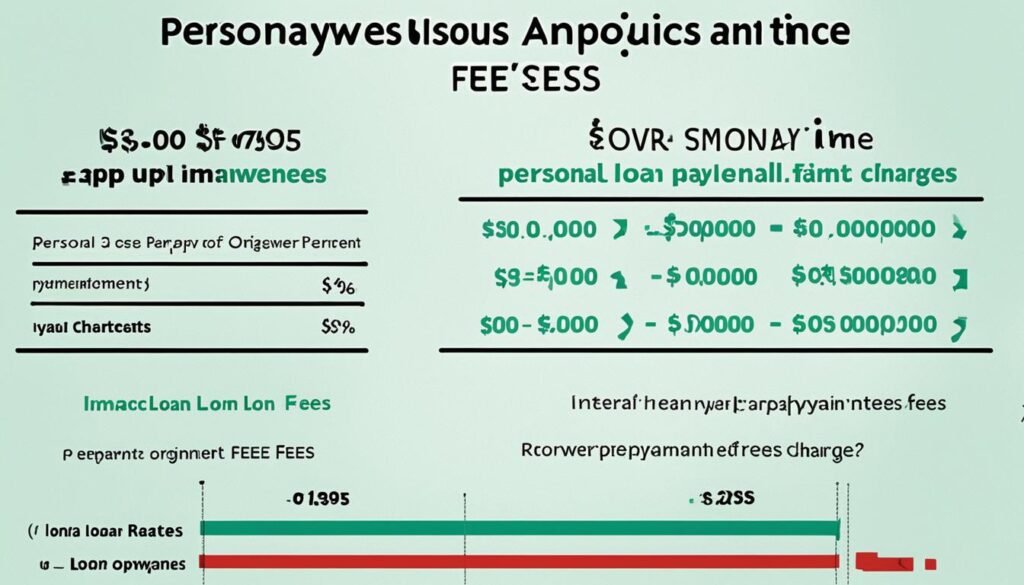Table of Contents
ToggleWhat Is A Personal Loan is a financial tool that allows individuals to borrow a lump sum of money from a lender, such as a bank or online lender. This borrowed amount is then repaid over a specific loan term through fixed monthly payments.
The key factors that determine the interest rate on a personal loan include the borrower’s credit score, which reflects their creditworthiness, and the lender’s assessment of the borrower’s ability to repay the loan.
Personal loans are a popular choice for individuals who need funds for various purposes, such as consolidating debt, renovating their homes, covering wedding expenses, or paying for medical bills. The flexibility of personal loans allows borrowers to address their financial needs effectively.
In the following sections, we will explore how personal loans work, the qualifications required to obtain one, the application process, interest rates, fees, and charges, as well as the differences between secured and unsecured personal loans.
Key Takeaways: What Is A Personal Loan
- A personal loan is a borrowed amount of money from a lender that is repaid over a specific loan term.
- The interest rate on a personal loan is determined based on factors such as the borrower’s credit score and the lender’s assessment of creditworthiness.
- Personal loans can be used for various purposes, including debt consolidation, home improvements, wedding expenses, and medical bills.
- Understanding how personal loans work, the qualification requirements, and the application process is essential before applying for a loan.
- Comparing loan offers and considering factors such as APR, monthly payment, fees, and funding time can help borrowers make an informed decision.
How Does a Personal Loan Work
A personal loan is a versatile financial tool that allows individuals to borrow a specific amount of money from a lender. It offers flexibility in terms of usage and repayment options. Understanding how a personal loan works is essential before considering borrowing.
When you apply for a personal loan, a lender will assess your creditworthiness, income, and other relevant factors to determine the loan amount and interest rate you qualify for. Once approved, you can borrow the funds and start using them for various purposes such as consolidating debt, funding home improvements, or covering unexpected expenses.
Unlike secured loans that require collateral, personal loans are typically unsecured. This means you don’t need to provide any assets as security. However, the interest rate on a personal loan is usually higher than that of secured loans due to the increased risk for the lender.
The borrowed amount needs to be repaid over a set period of time, usually in monthly installments. Each payment includes both the principal amount borrowed and the accrued interest. The repayment term can vary based on the loan agreement, ranging from a few months to several years.
Key Features of a Personal Loan:
- Borrow a specific amount of money.
- Repay the loan over a set period of time.
- Interest rate determined by creditworthiness and other factors.
- Unsecured, meaning no collateral is required.
Uses for a Personal Loan

Personal loans offer great flexibility and can be used for a wide range of purposes. Whether you need help consolidating your debts, improving your home, financing a wedding, or covering medical expenses, a personal loan can provide the funds you need.
Here are some common uses for a personal loan:
- Debt Consolidation: If you have multiple high-interest debts, consolidating them with a personal loan can simplify your finances and potentially save you money on interest payments.
- Home Improvement: Whether you’re renovating your kitchen, adding an extra bedroom, or making other upgrades, a personal loan can help you finance your home improvement projects.
- Wedding Expenses: Planning a wedding can be expensive, but a personal loan can help you cover the costs of the venue, catering, decorations, and more.
- Medical Bills: Unexpected medical expenses can put a strain on your finances. A personal loan can help you pay for medical treatments, procedures, or medications.
“A personal loan can be a lifeline when it comes to managing your finances. It provides the freedom to use the funds for various purposes, whether it’s consolidating debt, sprucing up your home, celebrating a special occasion, or taking care of medical expenses.”
No matter what your financial needs may be, a personal loan can provide the necessary funds to help you achieve your goals. However, it’s important to remember that responsible borrowing is crucial. Make sure to assess your financial situation and repayment capabilities before taking on a personal loan.
Next, we’ll discuss how to qualify for a personal loan and what lenders typically consider when evaluating your application.
How to Qualify for a Personal Loan

Qualifying for a personal loan requires lenders to assess various factors, including your credit score, income, and debt-to-income ratio. These criteria play an essential role in determining your eligibility for the loan. Here’s a breakdown of each factor:
Credit Score
Your credit score is a numeric representation of your creditworthiness. Lenders use it to gauge the level of risk associated with lending you money. A higher credit score indicates a lower risk, increasing your chances of approval for a personal loan. Conversely, a lower credit score may make it more challenging to qualify on your own.
Income
Your income serves as an indicator of your ability to repay the loan. Lenders assess your income to ensure you have sufficient funds to cover the monthly loan payments. A stable and consistent income demonstrates financial stability and reliability, making you a favorable candidate for personal loan approval.
Debt-to-Income Ratio
The debt-to-income ratio (DTI) is a measure of your debt compared to your income. It helps lenders assess your ability to manage additional debt responsibly. To calculate your DTI, divide your total monthly debt payments by your monthly income and multiply by 100. A lower DTI ratio, generally below 36%, indicates that you have a manageable level of debt and are more likely to qualify for a personal loan.
Co-signer
If you have a lower credit score or a higher DTI ratio, you may still be able to qualify for a personal loan by adding a co-signer to the application. A co-signer is someone with a strong credit history and income who agrees to take responsibility for the loan if you are unable to repay it. This additional level of security can increase your chances of approval and potentially help you secure a more favorable interest rate.
By understanding these qualifying factors, you can take steps to improve your eligibility for a personal loan. Maintaining a good credit score, managing your income and debt responsibly, and considering a co-signer if needed can enhance your chances of securing the loan you need.
How to Apply for a Personal Loan

Applying for a personal loan is a straightforward process that involves several key steps. By following these steps, you can navigate the application process smoothly and increase your chances of securing a personal loan that suits your needs.
- Research and Compare Lenders: Start by researching and comparing different lenders to find the one that offers the best terms and interest rates for your personal loan. Consider factors such as reputation, customer reviews, and loan options.
- Check Eligibility Requirements: Review the eligibility requirements of each lender to ensure that you meet the criteria. Common requirements include a minimum credit score, income verification, and a certain debt-to-income ratio.
- Complete the Application: Once you have selected a lender, complete the application form. This form will typically require you to provide personal information, such as your name, address, employment details, and financial information.
- Undergo a Credit Check: Most lenders will perform a credit check as part of the application process. This check helps the lender assess your creditworthiness and determine the interest rate you qualify for. Keep in mind that some lenders offer pre-qualification options where you can estimate your loan terms without undergoing a formal credit check.
- Provide Supporting Documents: In addition to the application, you may need to provide supporting documents such as pay stubs, bank statements, or tax returns to verify your income and financial stability.
- Review Loan Offers: Once you have submitted your application, lenders will review your information and provide loan offers if you meet their criteria. Carefully review the loan offers, taking into consideration the interest rates, repayment terms, and any additional fees or charges.
- Sign the Loan Agreement: If you decide to accept a loan offer, you will need to sign a loan agreement. This agreement outlines the terms and conditions of the loan, including the interest rate, repayment schedule, and any penalties for late payment or early repayment.
- Receive Funds: After signing the loan agreement, the lender will typically disburse the funds directly to your bank account. The time it takes to receive the funds can vary depending on the lender’s process.
Applying for a personal loan can be a convenient way to access the funds you need for various purposes. By understanding the application process and being prepared with the necessary information and documents, you can increase your chances of a successful loan application.
| Pros | Cons |
|---|---|
| Easy online application | Credit check may impact credit score |
| Access to funds for various purposes | May require supporting documents |
| Competitive interest rates | Approval is not guaranteed |
| No collateral required | Some lenders may charge origination fees |
Personal Loan Interest Rates

When considering a personal loan, it’s important to understand the interest rates associated with it. Personal loan interest rates are typically expressed as an annual percentage rate (APR), which includes both the interest rate and any fees charged by the lender.
The interest rate on a personal loan can vary based on several factors, including your credit score and the lender’s assessment of your creditworthiness. A higher credit score generally indicates a lower risk for the lender, which may result in a lower interest rate for the borrower.
It’s worth noting that personal loans may come with various fees, such as origination fees, late fees, and prepayment penalties. These fees can affect the overall cost of the loan and should be considered when evaluating different loan offers.
Personal Loan Interest Rates Comparison
| Lender | Interest Rate Range | APR | Fees |
|---|---|---|---|
| Bank A | 5.99% – 10.99% | 6.50% | $100 origination fee |
| Online Lender B | 7.99% – 15.99% | 9.25% | No fees |
| Credit Union C | 6.00% – 12.00% | 6.75% | $50 late fee |
As seen in the table above, different lenders may offer different interest rate ranges and APRs for personal loans. It’s essential to compare loan offers and consider the overall cost, including fees, before making a decision.
Secured vs. Unsecured Personal Loans

When it comes to personal loans, borrowers have two main options: secured and unsecured loans. The key difference between the two lies in whether or not collateral is involved.
Secured Personal Loans
A secured personal loan requires collateral, which serves as a form of security for the lender. Collateral can be in the form of a valuable asset, such as a car, home, or other property. If you default on the loan, the lender has the right to seize the collateral to recover their losses.
Secured loans are generally easier to qualify for and may offer lower interest rates compared to unsecured loans. This is because the lender has the added security of the collateral, reducing their risk. However, it’s important to note that failure to repay a secured loan can result in the loss of the collateral.
Unsecured Personal Loans
Unsecured personal loans, on the other hand, do not require collateral. These loans are typically based on the borrower’s creditworthiness, income, and other factors. Without collateral, lenders carry a higher risk, so unsecured loans often come with higher interest rates.
Without the need for collateral, unsecured personal loans offer borrowers greater flexibility and peace of mind. Borrowers don’t have to worry about losing valuable assets if they face financial difficulties.
When deciding between a secured or unsecured loan, it’s important to consider your own financial situation and what you’re comfortable with. If you have valuable collateral and are confident in your ability to repay the loan, a secured loan may offer lower interest rates and higher borrowing limits.
On the other hand, if you don’t have valuable collateral or prefer not to put your assets at risk, an unsecured personal loan may be the better option. While the interest rates may be higher, you won’t have to worry about losing your assets in the event of default.
Personal Loan Fees and Charges

When considering a personal loan, it’s essential to understand the fees and charges associated with the loan. Here are the main fees you might encounter:
1. Origination Fees
Origination fees are charges imposed by the lender for processing and funding the loan. These fees are typically a percentage of the loan amount and are deducted upfront when you receive the funds. Origination fees can range from 1% to 8% of the loan amount.
2. Late Fees
If you miss a payment or make a late payment on your personal loan, you may incur late fees. Late fees are imposed as a penalty for failing to make your payment on time. The specific amount of the late fee depends on the lender and the terms of your loan agreement.
3. Prepayment Penalties
Some personal loans may come with prepayment penalties, which are charges imposed if you pay off the loan before the designated term. These penalties are intended to compensate the lender for potential interest income lost due to early loan repayment. Prepayment penalties are generally expressed as a percentage of the outstanding loan balance.
It is important to carefully review the loan terms and conditions, including any potential fees and charges, before committing to a personal loan. Understanding these fees will enable you to make an informed decision and avoid any surprises.
| Fee | Description |
|---|---|
| Origination Fees | A percentage of the loan amount deducted upfront for processing and funding the loan. |
| Late Fees | Imposed if you miss or make a late payment, serving as a penalty for non-compliance with the loan repayment schedule. |
| Prepayment Penalties | Charges applied if the loan is paid off before the designated term, compensating the lender for potential lost interest income. |
Comparing Personal Loan Offers

When comparing personal loan offers, it’s important to consider several factors to ensure you’re making an informed decision. These factors include the APR, monthly payment, fees, and funding time.
The APR, or annual percentage rate, represents the total cost of the loan, incorporating both the interest rate and any associated fees. A lower APR generally indicates a more affordable loan.
Additionally, pay attention to the monthly payment amount, as this is the sum you’ll need to repay each month. A manageable monthly payment that fits within your budget is crucial for successful loan repayment.
Furthermore, it’s essential to be aware of any fees associated with the personal loan. These fees can include origination fees, late fees, or prepayment penalties. Understanding the potential fees will help you calculate the true cost of the loan.
Lastly, consider the funding time or how quickly you can receive the funds. Depending on your financial needs, you may require immediate access to the loan proceeds or be able to wait a bit longer. Assessing the funding time is particularly important for time-sensitive expenses.
| Factor to Consider | Description |
|---|---|
| APR | The APR represents the total cost of the loan, including interest and fees. A lower APR is generally more favorable. |
| Monthly Payment | Ensure the monthly payment is manageable and fits within your budget. |
| Fees | Be aware of any fees associated with the loan, such as origination fees, late fees, or prepayment penalties. |
| Funding Time | Consider how quickly you can receive the funds, especially if you have time-sensitive expenses. |
By comparing personal loan offers based on these factors, you can make an informed decision that aligns with your financial goals and needs.
Also Read: Personal Loan for Business: Finance Your Growth
Conclusion
In conclusion, a personal loan provides individuals with a flexible borrowing option to obtain a lump sum of money for various purposes. Whether you need funds for debt consolidation, home improvements, or even covering wedding expenses or medical bills, a personal loan can be a suitable solution.
With personal loans available from different lenders, it’s important to compare loan offers and carefully understand the terms and fees associated with each option. By doing so, you can make an informed decision that aligns with your financial goals.
Repayment of a personal loan is typically done over a set term, with fixed monthly payments. This allows you to manage your budget effectively and ensure timely repayment. Consider factors such as interest rates, loan terms, and any associated fees when assessing the overall affordability of a personal loan.
Remember, a personal loan offers flexibility and convenience, but responsible borrowing is crucial. Before taking out a personal loan, evaluate your financial situation and determine if it’s the right choice for you. By choosing the right loan option and managing your repayments responsibly, a personal loan can be a beneficial financial tool that helps you achieve your goals.
FAQs
Q: What is a personal loan?
A: A personal loan is a type of loan that allows you to borrow a fixed amount of money from a lender, which you then repay in monthly installments over a set loan term.
Q: How can I get a personal loan?
A: To get a personal loan, you can apply with a bank, credit union, or online lender. Make sure to check your credit report, improve your credit score if needed, and compare personal loan rates from different lenders to find the best option for you.
Q: How does using a personal loan differ from credit cards?
A: Using a personal loan involves borrowing a lump sum of money that you repay over time with fixed interest rates, whereas credit cards provide you with a revolving line of credit that you can use up to a certain limit.
Q: Can I get a personal loan with bad credit?
A: While it may be more challenging to get approved for a personal loan with bad credit, some lenders offer personal loans specifically for individuals with less-than-perfect credit. Improve your credit score and compare options to find the best personal loan for your situation.
Q: How does taking out a personal loan impact my credit score?
A: Taking out a personal loan can impact your credit score in both positive and negative ways. It can improve your credit if you make timely payments, but missing payments or defaulting on the loan can harm your credit score.
Q: What are the types of personal loans available?
A: Personal loans come in various forms such as installment loans, debt consolidation loans, and home equity loans. They can have fixed or variable interest rates and may be secured or unsecured depending on the lender.
Q: How can I use a personal loan to my advantage?
A: You can use a personal loan to pay off high-interest credit card debt, fund a home improvement project, consolidate debt, or cover unexpected expenses. Make sure to use personal loans responsibly to avoid financial strain.




